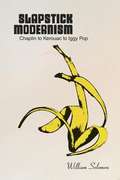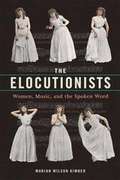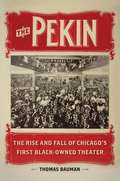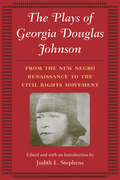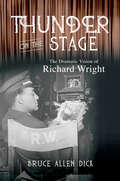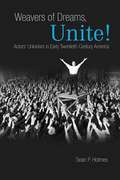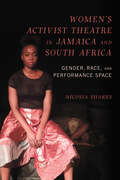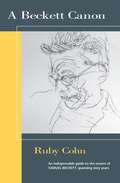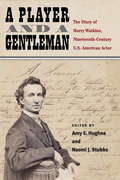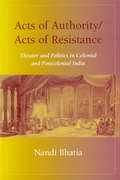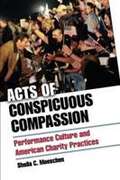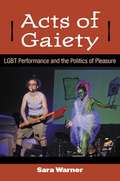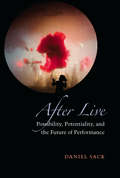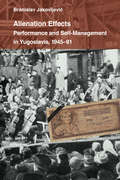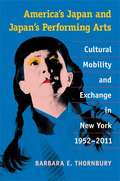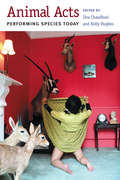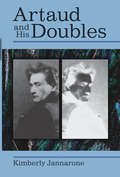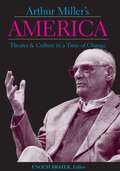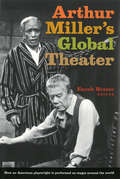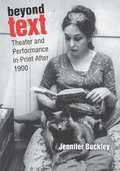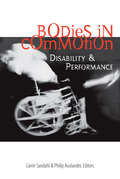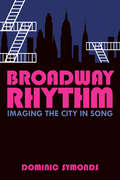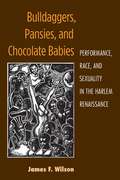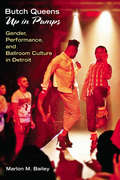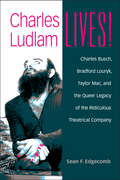- Table View
- List View
Slapstick Modernism: Chaplin to Kerouac to Iggy Pop
by William SolomonSlapstick comedy landed like a pie in the face of twentieth-century culture. Pratfalls and nyuk-nyuks percolated alongside literary modernism throughout the 1920s and 1930s before slapstick found explosive expression in postwar literature, experimental film, and popular music. William Solomon charts the origins and evolution of what he calls slapstick modernism --a merging of artistic experimentation with the socially disruptive lunacy made by the likes of Charlie Chaplin. Romping through texts, films, and theory, Solomon embarks on a harum-scarum intellectual odyssey from high modernism to the late modernism of the Beats and Burroughs before a head-on crash into the raw power of punk rock. Throughout, he shows the links between the experimental writers and silent screen performers of the early century, and explores the potent cultural undertaking that drew inspiration from anarchical comedy after World War Two.
The Elocutionists: Women, Music, and the Spoken Word
by Marian Wilson KimberEmerging in the 1850s, elocutionists recited poetry or drama with music to create a new type of performance. The genre--dominated by women--achieved remarkable popularity. Yet the elocutionists and their art fell into total obscurity during the twentieth century. Marian Wilson Kimber restores elocution with music to its rightful place in performance history. Gazing through the lenses of gender and genre, Wilson Kimber argues that these female artists transgressed the previous boundaries between private and public domains. Their performances advocated for female agency while also contributing to a new social construction of gender. Elocutionists, proud purveyors of wholesome entertainment, pointedly contrasted their "acceptable" feminine attributes against those of morally suspect actresses. As Wilson Kimber shows, their influence far outlived their heyday. Women, the primary composers of melodramatic compositions, did nothing less than create a tradition that helped shape the history of American music.
The Pekin: The Rise and Fall of Chicago's First Black-Owned Theater
by Thomas BaumanIn 1904, political operator and gambling boss Robert T. Motts opened the Pekin Theater in Chicago. Dubbed the "Temple of Music," the Pekin became one of the country's most prestigious African American cultural institutions, renowned for its all-black stock company and school for actors, an orchestra able to play ragtime and opera with equal brilliance, and a repertoire of original musical comedies. A missing chapter in African American theatrical history, Bauman's saga presents how Motts used his entrepreneurial acumen to create a successful black-owned enterprise. Concentrating on institutional history, Bauman explores the Pekin's philosophy of hiring only African American staff, its embrace of multi-racial upper class audiences, and its ready assumption of roles as diverse as community center, social club, and fundraising instrument. The Pekin's prestige and profitability faltered after Motts' death in 1911 as his heirs lacked his savvy, and African American elites turned away from pure entertainment in favor of spiritual uplift. But, as Bauman shows, the theater had already opened the door to a new dynamic of both intra- and inter-racial theater-going and showed the ways a success, like the Pekin, had a positive economic and social impact on the surrounding community.
The Plays of Georgia Douglas Johnson: From the New Negro Renaissance to the Civil Rights Movement
by Georgia Douglas JohnsonRecovering the stage work of one of America's finest black female writers This volume collects twelve of Georgia Douglas Johnson's one-act plays, including two never-before-published scripts found in the Library of Congress. As an integral part of Washington, D.C.'s, thriving turn-of-the-century literary scene, Johnson hosted regular meetings with Harlem Renaissance writers and other artists, including Countee Cullen, Langston Hughes, May Miller, and Jean Toomer, and was herself considered among the finest writers of the time. Johnson also worked for U.S. government agencies and actively supported women's and minorities' rights. As a leading authority on Johnson, Judith L. Stephens provides a brief overview of Johnson's career and significance as a playwright; sections on the creative environment in which she worked; her S Street Salon; "The Saturday Nighters," and its significance to the New Negro Theatre; selected photographs; and a discussion of Johnson's genres, themes, and artistic techniques.
Thunder on the Stage: The Dramatic Vision of Richard Wright
by Bruce Allen DickRichard Wright’s dramatic imagination guided the creation of his masterpieces Native Son and Black Boy and helped shape Wright’s long-overlooked writing for theater and other performative mediums. Drawing on decades of research and interviews with Wright’s family and Wright scholars, Bruce Allen Dick uncovers the theatrical influence on Wright’s oeuvre--from his 1930s boxing journalism to his unpublished one-acts on returning Black GIs in WWII to his unproduced pageant honoring Vladimir Lenin. Wright maintained rewarding associations with playwrights, writers, and actors such as Langston Hughes, Theodore Ward, Paul Robeson, and Lillian Hellman, and took particular inspiration from French literary figures like Jean-Paul Sartre. Dick’s analysis also illuminates Wright’s direct involvement with theater and film, including the performative aspects of his travel writings; the Orson Welles-directed Native Son on Broadway; his acting debut in Native Son’s first film version; and his play “Daddy Goodness,” a satire of religious charlatans like Father Divine, in the 1930s. Bold and original, Thunder on the Stage offers a groundbreaking reinterpretation of a major American writer.
Weavers of Dreams, Unite!: Actors' Unionism in Early Twentieth-Century America
by Sean P. HolmesPublished to coincide with the centenary of the founding of the Actors' Equity Association in 1913, Weavers of Dreams, Unite! explores the history of actors' unionism in the United States from the late nineteenth century to the onset of the Great Depression. Drawing upon hitherto untapped archival resources in New York and Los Angeles, Sean P. Holmes documents how American stage actors used trade unionism to construct for themselves an occupational identity that foregrounded both their artistry and their respectability. In the process, he paints a vivid picture of life on the theatrical shop floor in an era in which economic, cultural, and technological changes were transforming the nature of acting as work. The engaging study offers important insights into the nature of cultural production in the early twentieth century, the role of class in the construction of cultural hierarchy, and the special problems that unionization posed for workers in the commercial entertainment industry.
Women's Activist Theatre in Jamaica and South Africa: Gender, Race, and Performance Space (NWSA / UIP First Book Prize)
by Nicosia M. ShakesTheater is an essential theoretical and practical site for forging Black radical thought, Africana feminisms, and womanism. Nicosia M. Shakes draws on ethnographic research in Jamaica and South Africa to analyze the vital relationship between activism and theater production. Concentrating on four performance events, Shakes situates the work of theater groups and projects within a trajectory of women-led social justice movements established in Jamaica, South Africa, and globally from the early 2000s to the present. Her analysis reveals movements driven by Black women’s artistic, intellectual, and organizational labor and focused on issues that range from sexual violence to reproductive justice to the spatial manifestations of racial, gender, and economic oppression. Shakes shows how theater’s political and pedagogical roles become entangled with histories and geographies of oppression and resistance; the identities and connections created by movements of people in the context of colonial and settler colonial histories; and ideas of womanism and feminism.
A Beckett Canon
by Ruby CohnSamuel Beckett is unique in literature. Born and educated in Ireland, he lived most of his life in Paris. His literary output was rendered in either English or French, and he often translated one to the other, but there is disagreement about the contents of his bilingual corpus. A Beckett Canon by renowned theater scholar Ruby Cohn offers an invaluable guide to the entire corpus, commenting on Beckett's work in its original language. Beginning in 1929 with Beckett's earliest work, the book examines the variety of genres in which he worked: poems, short stories, novels, plays, radio pieces, teleplays, reviews, and criticism. Cohn grapples with the difficulties in Beckett's work, including the opaque erudition of the early English verse and fiction, and the searching depths and syntactical ellipsis of the late works. Specialist and nonspecialist readers will find A Beckett Canon valuable for its remarkable inclusiveness. Cohn has examined the holdings of all of the major Beckett depositories, and is thus able to highlight neglected manuscripts and correct occasional errors in their listings. Intended as a resource to accompany the reading of Beckett's writing--in English or French, published or unpublished, in part or as a whole--the book offers context, information, and interpretation of the work of one of the last century's most important writers.
A Player and a Gentleman: The Diary of Harry Watkins, Nineteenth-Century U.S. American Actor
by Amy E Hughes Naomi J StubbsHardworking actor, playwright, and stage manager Harry Watkins (1825–94) was also a prolific diarist. For fifteen years Watkins regularly recorded the plays he saw, the roles he performed, the books he read, and his impressions of current events. Performing across the U.S., Watkins collaborated with preeminent performers and producers, recording his successes and failures as well as his encounters with celebrities such as P. T. Barnum, Junius Brutus Booth, Edwin Forrest, Anna Cora Mowatt, and Lucy Stone. His is the only known diary of substantial length and scope written by a U.S. actor before the Civil War—making Watkins, essentially, the antebellum equivalent of Samuel Pepys. Theater historians Amy E. Hughes and Naomi J. Stubbs have selected, edited, and annotated excerpts from the diary in an edition that offers a vivid glimpse of how ordinary people like Watkins lived, loved, struggled, and triumphed during one of the most tumultuous periods in U.S. history. The selections in A Player and a Gentleman are drawn from a more expansive digital archive of the complete diary. The book, like its digital counterpart, will richly enhance our knowledge of antebellum theater culture and daily life in the U.S. during this period.
Acts of Authority/Acts of Resistance: Theater and Politics in Colonial and Postcolonial India
by Nandi BhatiaDespite its importance to literary and cultural texts of resistance, theater has been largely overlooked as a field of analysis in colonial and postcolonial studies. Acts of Authority/Acts of Resistance seeks to address that absence, as it uniquely views drama and performance as central to the practice of nationalism and anti-colonial resistance. Nandi Bhatia argues that Indian theater was a significant force in the struggle against oppressive colonial and postcolonial structures, as it sought to undo various schemes of political and cultural power through its engagement with subjects derived from mythology, history, and available colonial models such as Shakespeare. Bhatia's attention to local histories within a postcolonial framework places performance in a global and transcultural context. Drawing connections between art and politics, between performance and everyday experience, Bhatia shows how performance often intervened in political debates and even changed the course of politics. One of the first Western studies of Indian theater to link the aesthetics and the politics of that theater, Acts of Authority/Acts of Resistance combines in-depth archival research with close readings of dramatic texts performed at critical moments in history. Each chapter amplifies its themes against the backdrop of specific social conditions as it examines particular dramatic productions, from The Indigo Mirror to adaptations of Shakespeare plays by Indian theater companies, illustrating the role of theater in bringing nationalist, anticolonial, and gendered struggles into the public sphere.
Acts of Conspicuous Compassion: Performance Culture and American Charity Practices
by Moeschen Sheila C."Acts of Conspicuous Compassion" investigates the relationship between performance culture and the cultivation of charitable sentiment in America, exploring the distinctive practices that have evolved to make the plea for charity legible and compelling. From the work of 19th-century melodramas to the televised drama of transformation and redemption in reality TV s "Extreme Makeover: Home Edition," "Acts of Conspicuous Compassion" charts the sophisticated strategies employed by various charity movements responsible for making organized benevolence alluring, exciting, and seemingly uncomplicated. Sheila C. Moeschen brokers a new way of accounting for the legacy and involvement of disabled people within charity specifically, the articulation of performance culture as a vital theoretical framework for discussing issues of embodiment and identity dislodges previously held notions of the disabled existing as passive, objects of pity. This work gives rise to a more complicated and nuanced discussion of the participation of the disabled community in the charity industry, of the opportunities afforded by performance culture for disabled people to act as critical agents of charity, and of the new ethical and political issues that arise from employing performance methodology in a culture with increased appetites for voyeurism, display, and complex spectacle. "
Acts of Gaiety: LGBT Performance and the Politics of Pleasure
by Sara WarnerActs of Gaiety explores the mirthful modes of political performance by LGBT artists, activists, and collectives that have inspired and sustained deadly serious struggles for revolutionary change. The book explores antics such as camp, kitsch, drag, guerrilla theater, zap actions, rallies, manifestos, pageants, and parades alongside more familiar forms of "legitimate theater. " Against queer theory's long-suffering romance with mourning and melancholia and a national agenda that urges homosexuals to renounce pleasure if they want to be taken seriously by mainstream society, Acts of Gaiety seeks to reanimate notions of "gaiety" as a political value for LGBT activism. The book mines the archives of lesbian-feminist activism of the 1960s-70s, highlighting the outrageous gaiety that lay at the center of the social and theatrical performances of the era and uncovering original documents long thought to be lost. Juxtaposing historical figures such as Valerie Solanas and Jill Johnston with more recent performers and activists (including Hothead Paisan, Bitch & Animal, and the Five Lesbian Brothers), Warner shows how reclaiming this largely discarded and disavowed past elucidates possibilities for being and belonging. Acts of Gaiety explores the mutually informing histories of gayness as politics and as joie de vivre, along with the centrality of liveliness to queer performance and protest.
After Live: Possibility, Potentiality, And The Future Of Performance
by Daniel Aaron SackIn the dark of the blackout before the curtain rises, the theater holds its many worlds suspended on the verge of appearance. How can a performance sustain this sense of potentiality that grounds all live production? Or if a stage-world does begin, what kinds of future might appear within its frame? Conceiving of the theater as a cultural institution devoted to experimenting with the future, this book begins and ends on the dramatic sta≥ in between it traverses literature, dance, sculpture, and performance art to explore the various futures we make in a live event. After Live conceives of traditional dramatic theater as a place for taming the future and then conceptualizes how performance beyond this paradigm might stage the unruly nature of futurity. Chapters offer insights into the plays of Beckett, Churchill, Eno, and Gombrowicz, devised theater practices, and include an extended exploration of the Italian director Romeo Castellucci. Through the lens of potentiality, other chapters present novel approaches to minimalist sculpture and dance, then reflect on how the beholder him or herself is called upon to perform when confronted by such work.
Alienation Effects: Performance and Self-Management in Yugoslavia, 1945-91
by Branislav JakovljevicIn the 1970s, Yugoslavia emerged as a dynamic environment for conceptual and performance art. At the same time, it pursued its own form of political economy of socialist self-management. Alienation Effects argues that a deep relationship existed between the democratization of the arts and industrial democracy, resulting in a culture difficult to classify. The book challenges the assumption that the art emerging in Eastern Europe before 1989 was either "official" or "dissident" art; and shows thatthe break up of Yugoslavia was not a result of "ancient hatreds" among its peoples but instead came from the distortion and defeat of the idea of self-management. The case studies include mass performances organized during state holidays; proto-performance art, such as the 1954 production of Waiting for Godot in a former concentration camp in Belgrade; student demonstrations in 1968; and body art pieces by Gina Pane, Joseph Beuys, Marina Abramovic, and others. Alienation Effects sheds new light on the work of well-known artists and scholars, including early experimental poetry by Slavoj Ž iž ek, as well as performance and conceptual artists that deserve wider, international attention.
America's Japan and Japan's Performing Arts: Cultural Mobility and Exchange in New York, 1952-2011
by Barbara E. ThornburyAmerica’s Japan and Japan’s Performing Arts studies the images and myths that have shaped the reception of Japan-related theater, music, and dance in the United States since the 1950s. Soon after World War II, visits by Japanese performing artists to the United States emerged as a significant category of American cultural-exchange initiatives aimed at helping establish and build friendly ties with Japan. Barbara E. Thornbury explores how “Japan” and “Japanese culture” have been constructed, reconstructed, and transformed in response to the hundreds of productions that have taken place over the past sixty years in New York, the main entry point and defining cultural nexus in the United States for the global touring market in the performing arts. Thornbury crosses disciplinary boundaries in her wide range of both primary sources and published scholarship, making the book of interest to students and scholars of performing arts studies, Japanese studies, and cultural studies.
Animal Acts: Performing Species Today
by Holly Hughes Una ChaudhuriWe all have an animal story--the pet we loved, the wild animal that captured our childhood imagination, the deer the neighbor hit while driving. While scientific breakthroughs in animal cognition, the effects of global climate change and dwindling animal habitats, and the exploding interdisciplinary field of animal studies have complicated things, such stories remain a part of how we tell the story of being human. Animal Acts collects eleven exciting, provocative, and moving stories by solo performers, accompanied by commentary that places the works in a broader context. Work by leading theater artists Holly Hughes, Rachel Rosenthal, Deke Weaver, Carmelita Tropicana, and others joins commentary by major scholars including Donna Haraway, Jane Desmond, Jill Dolan, and Nigel Rothfels. Una Chaudhuri's introduction provides a vital foundation for understanding and appreciating the intersection of animal studies and performance. The anthology foregrounds questions of race, gender, sexuality, class, nation, and other issues central to the human project within the discourse of the "post human," and will appeal to readers interested in solo performance, animal studies, gender studies, performance studies, and environmental studies.
Artaud and His Doubles
by Kimberly JannaroneArtaud and His Doublesis a radical re-thinking of one of the most influential theater figures of the twentieth century. Placing Artaud's writing within the specific context of European political, theatrical, and intellectual history, the book reveals Artaud's affinities with a disturbing array of anti-intellectual and reactionary writers and artists whose ranks swelled catastrophically between the wars in Western Europe. Kimberly Jannarone shows that Artaud's work reveals two sets of doubles: one, a body of peculiarly persistent received interpretations from the American experimental theater and French post-structuralist readings of the 1960s; and, two, a darker set of doubles—those of Artaud's contemporaries who, in the tumultuous, alienated, and pessimistic atmosphere enveloping much of Europe after World War I, denounced the degradation of civilization, yearned for cosmic purification, and called for an ecstatic loss of the self. Artaud and His Doubleswill generate provocative new discussions about Artaud and fundamentally challenge the way we look at his work and ideas.
Arthur Miller's America
by Enoch BraterPerspectives on America's greatest living playwright that explore his longstanding commitment to forging a uniquely American theater Arthur Miller's America collects new writing by leading international critics and scholars that considers the dramatic world of icon, activist, and playwright Arthur Miller's theater as it reflects the changing moral equations of his time. Written on the occasion of Miller's 85th year, the original essays and interviews in Arthur Miller's America treat the breadth of Miller's work, including his early political writings for the campus newspaper at the University of Michigan, his famous work with John Huston, Clark Gable and Marilyn Monroe on The Misfits, and his signature plays like Death of a Salesman and All My Sons.
Arthur Miller's Global Theater
by Enoch BraterNo American playwright is more revered on the international stage than Arthur Miller. In Arthur Miller’s Global Theater—a fascinating collection of new essays by leading international critics and scholars—readers learn how and why audiences around the world have responded to the work of the late theatrical icon. With perspectives from diverse corners of the globe, from Israel to Japan to South Africa, this groundbreaking volume explores the challenges of translating one of the most American of American playwrights and details how disparate nations have adapted meaning in Miller’s most celebrated dramas. An original and engaging collection that will appeal to theater aficionados, scholars, students, and all those interested in Miller and his remarkable oeuvre, Arthur Miller’s Global Theater illustrates how dramas such as Death of a Salesman, The Crucible, and A View from the Bridge developed a vigorous dialogue with new audiences when they crossed linguistic and national borders. In these times when problems of censorship, repressive regimes, and international discord are increasingly in the news, Arthur Miller’s voice has never been more necessary as it continues to be heard and celebrated around the world.
Beyond Text: Theater and Performance in Print After 1900
by Jennifer BuckleyTaking up the work of prominent theater and performance artists, Beyond Text reveals the audacity and beauty of avant-garde performance in print. With extended analyses of the works of Edward Gordon Craig, German expressionist Lothar Schreyer, the Living Theatre, Carolee Schneemann, and Guillermo Gómez-Peña, the book shows how live performance and print aesthetically revived one another during a period in which both were supposed to be in a state of terminal cultural decline. While the European and American avant-gardes did indeed dismiss the dramatic author, they also adopted print as a theatrical medium, altering the status, form, and function of text and image in ways that continue to impact both the performing arts and the book arts. Beyond Text participates in the ongoing critical effort to unsettle conventional historical and theoretical accounts of text-performance relations, which have too often been figured in binary, chronological (“from page to stage”), or hierarchical terms. Across five case studies spanning twelve decades, Beyond Text demonstrates that print—as noun and verb—has been integral to the practices of modern and contemporary theater and performance artists.
Bodies in Commotion: Disability and Performance
by Carrie Sandahl Philip Auslander"A testament to the synergy of two evolving fields. From the study of staged performances to examinations of the performing body in everyday life, this book demonstrates the enormous profitability of moving beyond disability as metaphor. . . . It's a lesson that many of our cultural institutions desperately need to learn. " -Martin F. Norden, University of Massachusetts-Amherst This groundbreaking collection imagines disabled bodies as "bodies in commotion"-bodies that dance across artistic and discursive boundaries, challenging our understanding of both disability and performance. In the book's essays, leading critics and artists explore topics that range from theater and dance to multi-media performance art, agit-prop, American Sign Language theater, and wheelchair sports. Bodies in Commotionis the first collection to consider the mutually interpretive qualities of these two emerging fields, producing a dynamic new resource for artists, activists, and scholars.
Broadway Rhythm: Imaging the City in Song
by Dominic SymondsBroadway Rhythm is a guide to Manhattan like nothing you've ever read. Author Dominic Symonds calls it a performance cartography, and argues that the city of New York maps its iconicity in the music of the Broadway songbook. A series of walking tours takes the reader through the landscape of Manhattan, clambering over rooftops, riding the subway, and flying over skyscrapers. Symonds argues that Broadway's songs can themselves be used as maps to better understand the city though identifiable patterns in the visual graphics of the score, the auditory experience of the music, and the embodied articulation of performance, recognizing in all of these patterns, corollaries inscribed in the terrain, geography, and architecture of the city. Through musicological analyses of works by Gershwin, Bernstein, Copland, Sondheim and others, the author proposes that performance cartography is a versatile methodology for urban theory, and establishes a methodological approach that uses the idea of the map in three ways: as an impetus, a metaphor, and a tool for exploring the city.
Bulldaggers, Pansies, and Chocolate Babies: Performance, Race, and Sexuality in the Harlem Renaissance
by James WilsonBulldaggers, Pansies, and Chocolate Babies shines the spotlight on historically neglected plays and performances that challenged early twentieth-century notions of the stratification of race, gender, class, and sexual orientation. On Broadway stages, in Harlem nightclubs and dance halls, and within private homes sponsoring rent parties, African American performers of the 1920s and early 1930s teased the limits of white middle-class morality. Blues-singing lesbians, popularly known as "bulldaggers," performed bawdy songs; cross-dressing men vied for the top prizes in lavish drag balls; and black and white women flaunted their sexuality in scandalous melodramas and musical revues. Race leaders, preachers, and theater critics spoke out against these performances that threatened to undermine social and political progress, but to no avail: mainstream audiences could not get enough of the riotous entertainment.<P> Many of the plays and performances explored here, central to the cultural debates of their time, had been previously overlooked by theater historians. Among the performances discussed are David Belasco's controversial production of Edward Sheldon and Charles MacArthur's Lulu Belle (1926), with its raucous, libidinous view of Harlem. The title character, as performed by a white woman in blackface, became a symbol of defiance for the gay subculture and was simultaneously held up as a symbol of supposedly immoral black women. African Americans Florence Mills and Ethel Waters, two of the most famous performers of the 1920s, countered the Lulu Belle stereotype in written statements and through parody, thereby reflecting the powerful effect this fictional character had on the popular imagination.<P> Bulldaggers, Pansies, and Chocolate Babies is based on historical archival research including readings of eyewitness accounts, newspaper reports, songs, and playscripts. Employing a cultural studies framework that incorporates queer and critical race theory, it argues against the widely held belief that the stereotypical forms of black, lesbian, and gay show business of the 1920s prohibited the emergence of distinctive new voices. Specialists in American studies, performance studies, African American studies, and gay and lesbian studies will find the book appealing, as will general readers interested in the vivid personalities and performances of the singers and actors introduced in the book.
Butch Queens Up in Pumps: Gender, Performance, and Ballroom Culture in Detroit
by Marlon M. BaileyButch Queens Up in Pumpsexamines Ballroom culture, in which inner-city LGBT individuals dress, dance, and vogue to compete for prizes and trophies. Participants are affiliated with a house, an alternative family structure typically named after haute couture designers and providing support to this diverse community. Marlon M. Bailey's rich first-person performance ethnography of the Ballroom scene in Detroit examines Ballroom as a queer cultural formation that upsets dominant notions of gender, sexuality, kinship, and community.
Charles Ludlam Lives!: Charles Busch, Bradford Louryk, Taylor Mac, and the Queer Legacy of the Ridiculous Theatrical Company
by Sean EdgecombPlaywright, actor and director Charles Ludlam (1943–1987) helped to galvanize the Ridiculous style of theater in New York City starting in the 1960s. Decades after his death, his place in the chronicle of American theater has remained constant, but his influence has changed. Although his Ridiculous Theatrical Company shut its doors, the Ludlamesque Ridiculous has continued to thrive and remain a groundbreaking genre, maintaining its relevance and potency by metamorphosing along with changes in the LGBTQ community. Author Sean F. Edgecomb focuses on the neo-Ridiculous artists Charles Busch, Bradford Louryk, and Taylor Mac to trace the connections between Ludlam’s legacy and their performances, using alternative queer models such as kinetic kinship, lateral historiography, and a new approach to camp. Charles Ludlam Lives! demonstrates that the queer legacy of Ludlam is one of distinct transformation—one where artists can reject faithful interpretations in order to move in new interpretive directions.
